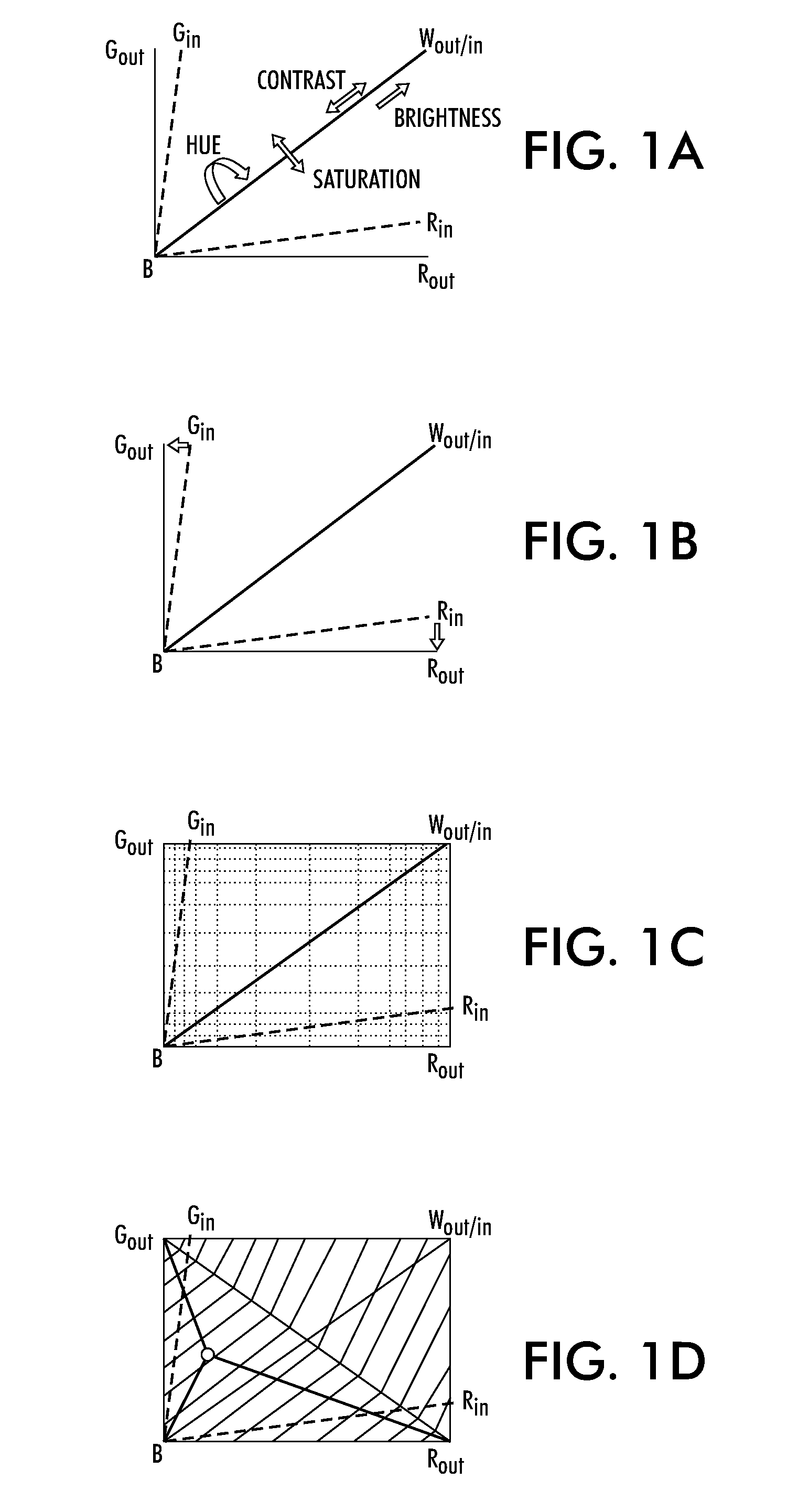LED brightness is currently limited, however, requiring three optical systems and three image modulators, i.e., one for each of the red, green, and blue (RGB) color channels, for the brightest images.
Such products offer the promise and technical challenge of how to best use the wide color
gamut.
Adding these multiple RGB channels during an
image frame duty cycle or area will increase the brightness, but will also reduce the
colorfulness by desaturating the pure RGB colors.
With these limited
processing options, it is not possible to display images optimally in human
visual system (HVS) perceptual terms.
For example, it is not possible to render visual
lightness contrast without affecting either or both of
hue and chroma.
. . is a very complicated experience .
Prior attempts to process the current video standards, such as with one-dimensional
color processing and color matrices, or without use of HVS models have resulted in unsatisfactory and unrealistic displayed images and high rates of product return by consumers.
Thus gamma controls are global, with no way to locally isolate colors, such as
flesh tones.
Because of power, heat, and size limitations, these displays generally have reduced color gamuts due to reduced contrast or reduced
color saturation.
Additionally, the capabilities of HVS
adaptation are affected by the viewing environment.
To do so would result in images containing certain details that appear unsatisfactory to a human observer.
For example, if a
flesh tone of a face in an image is modified in the same manner as a relatively saturated color of another object in the image, the face will be perceived as “pink,”“orange,” or “burnt” by an observer and thus will be perceived as unsatisfactory.
Prior attempts to process the video inputs with one-dimensional
color processing and color matrices for such extended brightness, contrast or color gamut displays, have resulted in unsatisfactory and unrealistic displayed images and high rates of product return by consumers.
Current projectors, televisions or displays that attempt to enhance or improve perceived
color quality with
processing that is in any way different than exact colorimetric
color reproduction, do not preserve memory colors in the background.
The algorithms used in current image displays, televisions and projectors cannot uniquely preserve a volume within a three-dimensional
color space while changing a different volume within the same three-dimensional
color space using one dimensional tables, or matrices, or enhancements which are applied to all colors in the 3D space.
This may allow one to provide a
bright white in an image without changing red, for example, but it does not allow one to specify any point or localized volume of a memory color in a 3D
color space, which is required to preserve that memory color.
As a result, when current image displays, televisions and projectors provide enhanced colors, they do so across the entire color gamut, “enhancing” certain memory colors such as
flesh tones such that a typical human observer finds them unsatisfactory and not perceptually optimal.
In such image devices, the
color enhancement is somewhat arbitrary; it does not preserve memory colors, nor produce a perceived display image that is realistic for a better viewing environment.
These 3D look-up-tables are used instead of one dimensional tables and 3×3 matrices because the small 3D look-up-tables are generally faster, albeit at the expense of some loss of precision.
In any case, significant color improvement or enhancements to deliver color “looks,” or gamut mapping or mapping to displays with secondary or more than three primary colors with such small tables is not possible.
Another problem in certain types of image rendering devices is that the outputs of the
primary color light sources are not stable.
A known problem with
OLED displays is that the blue
OLED typically has had a considerably shorter lifespan than the red and green OLEDs.
This change is much more objectionable to a viewer than a decrease in overall brightness of the display.
To the best of the applicants' knowledge, the problem of managing the overall lifespan of OLED displays has not be solved adequately, which has led to significant delays in product introduction in the marketplace.
Another problem in certain types of image rendering devices is that the battery life of the device is not sufficient to satisfy users' needs.
In a typical hand-held device, both the increase in the
duty cycle and the demand for maximum perceived
image quality of the display have placed a heavy burden on the batteries used to power such devices.
The also find that they cannot use their devices as often as they would like (in some cases nearly continuously over the course of a day), without carrying some sort of a charging cord and plug that connects to a 12
volt automobile jack, a 120 VAC outlet, or a
USB port.
This is a significant annoyance, and device makers recognize the overall problem.
However, this is clearly unsatisfactory, because space within any of these devices is at a premium, and manufacturers are unwilling to allocate additional volume to batteries when it is needed for many other purposes of equal or greater priority.
This generally results in a reduction in the brightness of the display, which is also unsatisfactory to consumers, particularly when viewing the display in full
daylight.
In prior art image displays and projectors in which traditional matrices and one dimensional color tables operate independently on the RGB input colors, a brighter display is not possible without affecting
hue.
In some circumstances, the image rendering unit (such as, e.g., a display or projection device) is provided with some color modification capability that is “built in.” For example, the device may provided with an
algorithm to add white or secondary colors, resulting in a loss of
colorfulness, and a
distortion in the appearance of memory colors.
However, such a modification to the primary colors will change the color gamut of the display, including its
white point.
Without corrective action, this can result in colors being rendered by the display that are unsatisfactory to the viewer.
 Login to View More
Login to View More  Login to View More
Login to View More 


